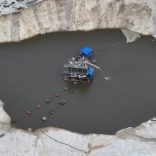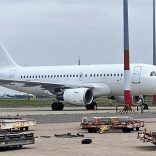Mozambique: MIREME begins socialization of extractive sector legal framework
Eni: maybe the last conventional E&P major in the world

Lettera (File photo) / Claudio Descalzzi
The sale of 25% stake in the Area 4 block in Mozambique to ExxonMobil signal once more Eni’s “dual-exploration” model, which aims at strictly controlling costs and optimizing the supply chain. Analysts have been raising their rating on the Italian firm’s shares, stating its unique position in the E&P segment, which will ultimately boost its operational cash flow in the next five years.
Since its five-year peak in 2014, natural gas prices have more than halved, falling from a little more than six dollars to $2.95 MMBtu at Nymex. Just as with oil, conventional exploration & production (E&P) has become particularly challenging, even for multinational oil and gas companies. In response to this new market environment, many of them have turned to unconventional E&P and acquisitions to remain profitable.
CEO of Eni since the year the oil and gas prices started collapsing, Claudio Descalzi has quite a different approach. He actually wants to turn the Italian-based and highly diversified company into a more focused E&P enterprise. For instance, the group sold several pipeline and oilfield services businesses. From this perspective, it comes as no surprise that Eni Mozambique finally announced the sale of interests in its gas-rich Area 4 block, offshore Mozambique, to ExxonMobil for $2.8 billion.
The long term transformation of Eni into an E&P focused company requires a model in which costs are minimized. This means making partnerships with other experimented competitors that can share the costs, while freeing up capital for Eni.
“This deal represents material evidence of our exploration strategy based on the early monetization of our exploration discoveries, as a part of our dual-exploration model”, confirms Eni’s CEO, commenting the sale and purchase agreement with ExxonMobil to acquire an Eni’s 25 percent stake in the Area 4 block.
While Eni will continue to lead the Coral floating liquefied natural gas (LNG) project and all upstream operations in Area 4, ExxonMobil will lead the construction and operation of natural gas liquefaction facilities onshore. This strategy based on early monetization has enabled Eni to cash in more than $9 billion in the last four years.
The average upstream cost of Eni’s new projects was reduced from an already low $30 barrels of oil equivalent per day (boe) level in 2014 to around $20/boe today. This cost structure is built on exploration costs of less than $1.5, opex of $7 and capex of $11/boe.
Such strategic moves by Eni have precedents in Africa. In December last year, Eni agreed to sell a 30 percent stake in its giant Egyptian offshore gas field Zohr to Russia-based Rosneft for $1.575 billion. This transaction occurred less than a month after the sale of another 10 percent stake in the same gas field to Russia-based Rosneft for more than $2 billion.
According to Goldman Sachs, Eni’s approach on conventional E&P will make it the top cash flow-making machine among major oil & gas companies. Its operating cash flow as a percentage of total cash flow should increase by more than 65% by 2021. The same ratio should only increase by less than 20 percent for ExxonMobil, less than 30 percent for Shell, while Chevron may see its own operating cash as a percentage of total cash flow grow by almost 50% during the next five years.
“Among the European majors, only Eni has been able to successfully translate exploration activities into valuable giant oil and gas discoveries”, says Michele Della Vigna, analyst at Goldman Sachs, who initiated a coverage of the stock with a “Buy” rating last month.
“The industry has forgotten how to do exploration,” said Claudio Descalzi in an interview with the Financial Times, last week. He added that while “everybody else” was looking for tar sands or tight oil or acquisitions he thought “there was still potential in conventional exploration”.
As a result of this reduced interest from oil & gas companies – in part due to currently low level of energy prices – global discoveries of new fields have dropped substantially last year. IHS Markit reported that discoveries of new oil and gas fields had dropped to a 60-year low in 2016, with only 174 discoveries (76 in conventional oil, 75 in conventional gas) against an annual average of 400 to 500.
In the meantime, Eni’s ongoing conventional exploration activity has resulted in a reserve-replacement ratio of 139% for the firm, many times greater than industry average and including the effect of the disposal of Zohr in Egypt. Its organic reserve-replacement ratio even surged to 193%, the best ever performance in Eni’s history.
Thanks to a strong production in the last quarter of 2016, a high proved reserve-replacement ratio, a well-stocked pipeline of new and high quality projects Eni aims at increasing production by 3% per year on average in the next four-year period, while intensifying the restructuring process of its mid-downstream businesses.
“The solidity of our balance sheet has been preserved by maintaining a sustainable level of gearing, while Eni has been the only Major to reduce its leverage during the 2014-2016 period”, explains Claudio Descalzi in Eni’s annual report published last week.
By Levy-Sergio Mutemba













Leave a Reply
Be the First to Comment!
You must be logged in to post a comment.
You must be logged in to post a comment.